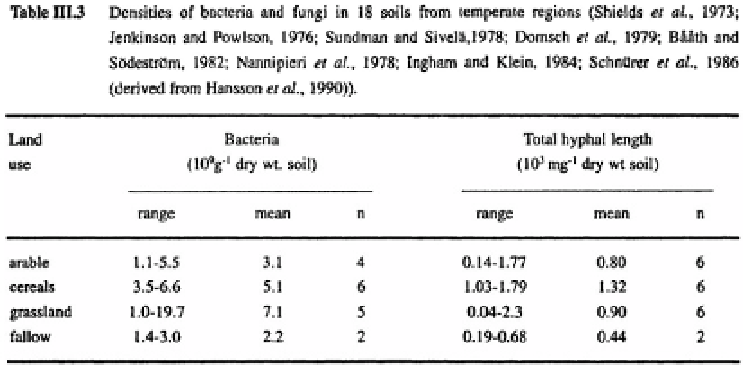Agriculture Reference
In-Depth Information
(Domsch
et al.,
1979). Bae
et al.
(1972) calculated that plating techniques can only
detect 0.1 to 1 % of the organisms present.
Biomass estimates obtained from the chloroform fumigation technique, direct counts
and ATP analyses are often comparable (see compilation in Jenkinson and Ladd, 1981
and Jenkinson, 1988). However, the fumigation technique is less efficient at acid pH
levels less than 4.5 (Anderson and Domsch, 1978; Amato and Ladd, 1994) and the
conversion of ATP content or FDA activity into biomass estimates may be of dubious
value (Ross
et al.,
1980). Finally, Jenkinson and Ladd (1981) recommend using more
than a single method and Nicolardot
et al.
(1982) make a clear distinction between
methods which estimate biomass directly (direct counts, chloroform fumigation) and
index methods which asses the activity of microflora (ATP content, FDA activity,
respirometry). The cross calibration of the two sets of methods is potentially difficult.
2.2.2
DENSITY, BIOMASS AND PRODUCTIVITY OF THE MICROFLORA
There have been relatively few estimates of the population densities of micro-organisms.
The use of methods with unequal efficiencies makes comparisons and comprehensive
approaches difficult. However, the studies that use direct counting methods associated
with specific staining are considered to give realistic assessments. Densities in soils may
be as high as bacteria (in Japanese paddy fields, Hasebe
et al.,
1984) and
of fungal hyphae (in the F layer of a
Pinus
stand in Sweden, Söderström, 1979).
In twenty soils from temperate regions, bacterial populations ranged from 1.1 to 19.7
dry wt of soil, with a mean value of 4.64 (Table III.3). Hyphal length ranged
from 0.14 to 2.03 dry wt with an average of 0.88 km. Differences have been found
between agricultural treatments with bacterial densities decreasing from grasslands to
fallows while cereals and other crops have intermediate densities. Hyphal length showed
a different pattern of variation, with cereals having the maximum values, three times
greater than that of fallows.





